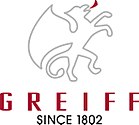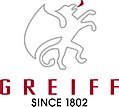Grab fashion
| GREIFF Mode GmbH & Co. KG
|
|
|---|---|
| legal form | GmbH & Co. KG |
| founding | 1802 |
| Seat | Bamberg , Germany |
| management | Jens Möller, Hans-Peter Beck |
| Number of employees | 120 (2018) |
| Website | www.greiff.de |
The GREIFF Mode GmbH & Co. KG is a German manufacturer of workwear based in Bamberg .
history
1802-1916
In 1802 the company JG Ihle was founded in Greiffenberg in Silesia and the production of linen began . These were woven and also printed, which is evident from documents from 1885. At the turn of the century it changed its name to Schlesische Blaudruckerei AG . Along with the name change, there was also a change in the company's production. Because from now on the new focus was on blue print, piece goods, other colored goods and blue print aprons.
1917-1944
In 1917 the company was taken over by Gustav Winkler , who worked as a handkerchief manufacturer in Silesia and had already gained experience in the textile sector.
Six years later, in 1923, his son Helmut Winkler took over the company. Under his leadership, the company's production program changed again, this time towards workwear. In addition to this new focus within production, summer jackets and pants, motorcycle clothing and hiking fashion were also produced. Again the name was changed to GREIFF in the 1920s .
In 1930/31 assembly lines were set up in the production halls for the first time, as a result of which the structure of the company changed from a craft business to a large-scale industrial production. In 1932 the first branch was set up in Lauban , Lower Silesia . In 1933 and 1934 two further branches were established in Frankfurt an der Oder and in Lomnitz in Silesia. In this phase the name was changed again, this time to GREIFF-Werke AG . At the same time as this name change, the first outsourcing within production followed. Piece goods and aprons were now taken over by the company Schlesische Schürzenfabrik , which was founded especially for this purpose and which is also based in Greiffenberg.
In the 30s there was a collaboration with IG Farben Industrie . The result of this collaboration was a new dyeing process in which the clothes were indanthrene - dyed. At that time, GREIFF-Werke AG was the first and only company to use this complex and demanding process.
Through increased advertising in combination with the new offers, the company was able to afford to take over the Lauffenmühle spinning and weaving mill in Unterlauchringen in 1935 . Now the company has been able to expand its product range to include sports jackets and sports suits for men and boys.
In 1936, company representatives showed their products at the Leipzig Trade Fair for the first time .
In the following three years, 1937 and 1939, two further branch plants were founded in Löwenberg / Silesia and in Bärnsdorf.
From 1945
The beginning of the Second World War stopped the company's expansion. At the end of the war, the company's employees, including the managing director Winkler and his wife, had to flee westwards.
Almost all equipment and materials had to be left behind. The end of the flight was the city of Bamberg . This was probably chosen because the Winkler couple studied there and therefore they knew it. Small production started here in the same year.
With the support of the mayor, the company was accepted into the Gaustadt spinning mill , a branch of the Erlangen-Bamberg cotton mill . The first branch was soon opened in Aalen in Baden-Württemberg .
Due to a lack of space, it was finally decided in 1947 to build a new building for the company. The company site for the first construction was 6000 m² and was located on the eastern edge of Bamberg. Two years later 98 employees found a job there, in 1950 there were already 600. Since the size of the production halls was no longer sufficient, the production area was expanded by 5000 m². In 1955, 1,500 employees found a job, who now also produced winter coats and men's suits.
In 1957 the number of employees rose to 2,500. In 1959 another branch was founded in Würzburg , which employed 500 people.
At the end of the 50s, the style of the collection changed. Attempts were also made to add fashionable accents. That is why the GREIFF company was able to appear for the first time at the men's fashion week in Cologne in 1963 .
In the mid-1960s, another branch for workwear was opened in Aub , and at the same time the branch in Würzburg was converted to men's suits / boys' suits. At the same time, attempts were made to reach the European market, which is why the company was present at the SEHM in Paris for the first time .
Due to the success of the fair, the first sales warehouses were opened in Belgium in 1966 and Paris in 1968. In the same year the company acquired and expanded a special plant for the production of trousers in Laufach .
In 1969, a subsidiary called GREIFF-Herrenbekleidung GmbH was founded in Vienna , Austria , and was to be the carrier of all exports to Austria. The GREIFF collection was exhibited at the HAKA trade fair in IMBEX.
At the beginning of the 1970s, the expansion of exports outside of Europe began in Kenya , Egypt , Lebanon , Australia and Canada . At the same time, the fluctuation-related downsizing began . In 1975, GREIFF only employed 2,000 people and in 1979 only 1,000 people on an area of 168,000 m², as production times could be greatly reduced.
Chronicle of the management
- 1802 Johann Gottfried Ihle
- 1917 Gustav Winkler
- 1923 Helmut Winkler
- 1983 Bernd-Dietmar Wendland
- 1993 Ralph Meincken
- 1997 Werner Ortmann
- 1999 Roland Spies
- 2001 Andrea Fuhrmann-Czermak
- 2003 Winfried Wagner
- 2006 Jens Möller, Hans-Peter Beck
Logos
Others
One of the most famous former employees is Arno Schmidt . He began his apprenticeship there in 1934: “Leave it to me to continue describing my work, I am stupid,” he wrote to his GREIFF colleague Alice Murawski, who became his wife in 1937. He worked as a warehouse accountant until 1940, before becoming famous with novels such as Leviathan , Brand's Haide and Schwarze Spiegel .
From 1961 to 1965, the retired Rear Admiral and commander of the German fleet, Rolf Johannesson, was an authorized signatory.
Individual evidence
Grab messenger
- ↑ GREIFF fashion | since 1802 | History. Archived from the original on September 4, 2018 ; accessed on April 6, 2019 (German).
- ↑ GREIFF certificate 1 (PDF; 258 kB)
- ↑ GREIFF certificate 2 (PDF; 145 kB)
- ↑ Letter to the Mayor of Bamberg (PDF; 260 kB)
- ↑ Letter to the city administration of Bamberg (PDF; 46 kB)
- ↑ Letter to the asset management city of Bamberg (PDF; 45 kB)











